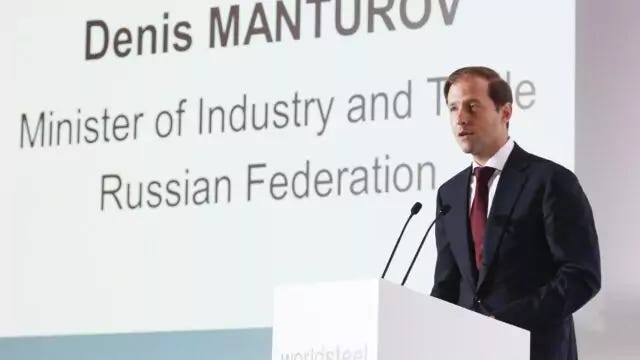(Source: Sputnik)
Executive Summary:
Russian Deputy Prime Minister Denis Manturov recently claimed that 520,000 workers have been added to the country’s military-industrial complex since the beginning of 2023, though he conceded that the sector is still facing a deficit of 160,000 employees.
These estimates, however, misrepresent a complicated situation in properly replacing retired employees while hoping to maintain the size of the workforce. The deficit is likely more serious than Manturov admits.
Problems in the workforce, especially in defense production, put limitations on arms manufacturing rates and compromise Moscow’s ability to maintain its war machine.
In early June, Denis Manturov, the Russian deputy prime minister responsible for the industrial sector, declared that the Russian military-industrial complex has reportedly employed 520,000 workers, engineers, and other personnel since the beginning of 2023. He added that more than 850 private civilian companies have become a part of Russian industrial development and production. Manturov, nevertheless, admitted that there is still a deficit of 160,000 employees in the sector. In June 2022, Yuri Borisov, Manturov’s predecessor, estimated the workforce deficit in the Russian arms industry at 400,000, including 120,000 engineers (Government.ru, June 6, 7; TASS, June 29, 2022). These official pronouncements highlight the shortage of workers and technical expertise that continues to plague Russia’s defense production. The crisis has been exacerbated by heavy losses in Ukraine and could compromise Moscow’s ability to carry out and sufficiently supply the long war.
Official Russian statements intend to convey that the current deficit is not an unsolvable problem. The reality, however, is much more complicated. The deficit in the workforce is growing and is far from being filled. The main challenge for Russian industrial leadership is replacing aged and retired personnel with new people to maintain the current size of the workforce, all while not losing critical technical expertise and experience. The shortage of personnel puts objective limitations on arms production rates.
Before 2022, official statistics claimed that 1,355 entities with about two million employees made up the Russian military-industrial complex, including 1.4 million employees directly engaged in arms production. These official numbers have remained relatively stable over the past decade (Government.ru, April 19, 2017; Government.ru, April 11, 2018). During the “partial” mobilization in 2022, however, only 830,000 employees in the military-industrial complex and other related sectors were exempted from both mobilization and conscription. The typical share of male employees is between 55 and 60 percent of the Russian workforce, and 16 to 18 percent of employees are over the age of 60. As such, the actual number of personnel in the Russian military-industrial complex could be estimated at 1.6 million employees by the beginning of 2023 without a distinction between arms production and the production of civil goods. Briefly speaking, Borisov’s assessment of the workforce deficit was accurate—the difference between two million jobs and 1.6 million actual employees comes to 400,000 (TASS, March 8, 2021; Kremlin.ru, December 21, 2022; Roscosmos.ru, accessed June 27, 2024; Journal.almaz-antey.ru, accessed June 27, 2024).
Regarding Manturov’s supposed 520,000 new employees, several key aspects should be considered. To begin with, permanent employee turnover remains an important element in determining the true size of the manufacturing sector’s workforce (Rossatat.gov.ru, accessed June 27, 2024):
According to this data, most of the new workforce in 2023–24 would replace retired employees as happened in previous years. Consequently, Manturov’s 520,000 new employees do not all correspond to an increase in the workforce. with the actual increase likely being much lower.
This point is confirmed by data from state-owned military-industrial corporation Rostec, which is responsible for 40 percent of total arms supplies in Russia. During 2023, the corporation increased its number of personnel by 12 percent, from 590,000 in 2019–22, which was relatively stable, to 660,000 people. This increase included about 8,000 employees of the state-owned Sverdlov production factory in Dzerzhinsk, which was subordinated to Rostec in 2023 (Rostec.ru, May 3; Interfax-russia.ru, April 20, 2023).
The comparable increase of workforces in other entities of the military-industrial complex (most related to Rostec) took place in Russia’s Perm region. At the end of 2023, 53,000 employees worked in the region’s industrial sector, 9,000 more than in 2022. However, 3,000 of these 9,000 employees were temporary workers with short-term contracts (likely employed for construction projects). As a result, the actual increase of employees was 6,000 (about 14 percent), from 44,000 to 50,000, and the staffing needs of the arms manufacturing sector in the region was estimated at 3,000 employees for 2024–25 (Admin.permkrai.ru, November 2, 2023).
These numbers can be applied to the Russian military-industrial complex as a whole. Doing so reveals that the total number of employees likely increased only slightly, from 1.6 million to 1.8 million. It hardly could have exceeded two million employees. Even the additional 850 civilian entities added to the register of the military-industrial complex cannot significantly change the situation. These entities are temporary contractors and sub-contractors of production facilities within Russia’s military-industrial complex. They supply imported components and other goods, including commercial drones, and materials for strengthening the defensive lines in the occupied territories of Ukraine. Thus, Russia’s workforce shortages place growing limitations on arms production, which looks to become an increasingly serious problem for the Kremlin as it struggles to maintain the current offensive against Ukraine.
This article was originally published in Eurasia Daily Monitor.
Dr. Pavel Luzin is a visiting scholar at the Fletcher School of Law and Diplomacy, Tufts University. He is also a regular contributor at The Jamestown Foundation, Riddle and the Foreign Policy Research Institute.





